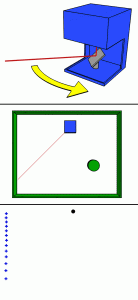The real voyage of discovery consists not in seeking new landscapes, but in having new eyes (Marcel Proust)
LiDAR (Light Detection And Ranging) or ALA (Airborne Laser Altimetry) is a relatively new technique in the toolbox of landscape archaeology. It is a new way of looking at the earth’s surface and produces a high resolution, highly accurate data. The ability to detect height differences of a few centimetres can reveal features on the surface – natural or artificial – which were previously invisible.
LiDAR uses the same principle as RADAR , but uses a laser beam instead of radio waves. An aircraft mounted laser projects a laser beam at the ground. This beam interacts with the targets it encounters. Some of this laser radiation is reflected to the instrument where it is analysed. The time for the laser pulse to travel back and forth is used to determine the range to the target, while changes in the properties of the laser beam enables some properties of the target to be determined.
LiDAR can often record the ground beneath the vegetation, as the laser beam can penetrate through the semi-opaque objects (such as trees) and part of the beam is reflected from the ground. The receiver on board of the aircraft is able to record multiple returns (reflections) for a single pulse. The “first pulse” reflects the top of semi-opaque objects such as leaves and branches while the „last pulse” enables to record the elevation of the ground beneath the semi opaque object.
Intensity of the backscattered laser pulse is usually recorded too. Backscattered intensity values vary according to changes in reflectance of different surfaces. Most of the LiDAR lasers operate in the Near-InfraRed (NIR) spectrum, so they also enable a low resolution, NIR image of the ground.
By interpolating the raw data, a continuous mathematical model representing the shape of the surface can be created. Several Digital Terrain Models (DTMs) can be interpolated from the LiDAR data: the Digital Surface Model (DSM), which describes the Earth’s surface with all the objects on the ground such as houses, trees, pylons … and the Digital Elevation Models (DEMs), which are free of “landscape clutter” and represent the bare surface.
The LiDAR data is usually processed, analysed, and visualised within a Geographical Information System (GIS), where it can be integrated with other sources. The huge amounts of information provided by LiDAR (millions of points per square kilometre) can be successfully visualised using techniques such as analytical hill shading, visualisation of elevations by colour ramps or new methods such as sky-view factor. LiDAR derived DEMs can be further analysed using the whole spectrum of tools delivered by most GIS packages.
LiDAR therefore gives researchers “new eyes” for the recognition of the minuscule variations in the Earth’s surface, results of anthropogenic features or geomorphological processes. Its capability to see below the vegetation enables archaeologists to identify features hidden beneath the woodland cover. Moreover, LiDAR can cover large areas of landscape with a resolution and accuracy previously unavailable. However, as the quantity of LiDAR data is still increasing, processing and interpretation of these results will provide new challenges.



